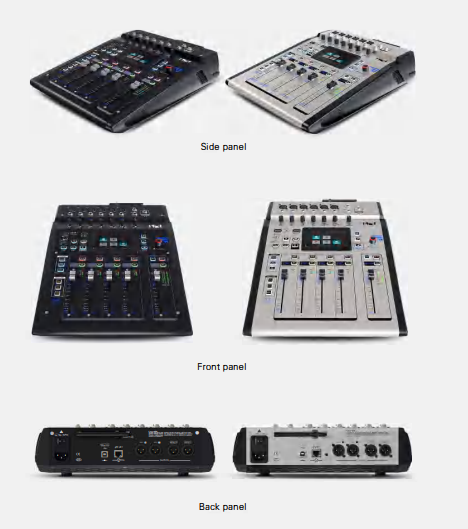Mastering Techniques for 10 & 12 Channel Digital Mixers
Digital mixers have revolutionized the audio industry, offering unparalleled flexibility, precision, and convenience for sound engineers and musicians alike. With advanced capabilities packed into compact designs, 10- and 12-channel digital mixers are ideal for small to medium setups, from live performances to studio recordings. This guide will help you master essential techniques for getting the best out of your digital mixer and elevating your sound mixing skills.

Understanding the Basics of Digital Mixers
What Are Digital Mixers?
Digital mixers are audio devices that manage multiple input and output channels, process audio signals, and provide advanced routing and effects options. Unlike analog mixers, digital mixers use digital signal processing (DSP) to manipulate sound with exceptional precision and versatility.
Why Choose 10 & 12 Channel Digital Mixers?
- Compact and Portable: These mixers are lightweight and easy to transport, making them ideal for smaller gigs and setups.
- Sufficient Inputs: With 10 to 12 channels, these mixers accommodate a variety of instruments, microphones, and playback devices.
- Built-in Effects: Many models include onboard EQ, compressors, and reverb, eliminating the need for external equipment.
Key Features of 10 & 12 Channel Digital Mixers
Intuitive Interface
Digital mixers often feature touchscreens or app-based controls, allowing for easy navigation and adjustments.
Scene Memory and Presets
With scene recall, you can save and retrieve custom settings for different performances, saving time during setup.
Flexible Routing
Routing options in digital mixers provide precise control over signal paths, including subgroups, aux sends, and direct outputs.
Essential Techniques for Using Digital Mixers
Input Gain Staging
Proper gain staging ensures clean, distortion-free audio. Adjust the input gain on each channel so that the signal peaks are in the optimal range, avoiding clipping or noise.
Steps for Gain Staging
- Set the fader to unity gain (0 dB).
- Adjust the input gain knob until the signal peaks just below the red zone on the meter.
- Fine-tune for clarity and balance.
Utilizing Built-in EQ and Effects
Digital mixers typically offer multi-band EQs and effects processing on every channel. Use these tools to shape the tone of each input and create a cohesive mix.
Practical Tips for EQ
- Cut unnecessary low frequencies on vocals and guitars to reduce muddiness.
- Boost high frequencies slightly for added clarity.
- Use the midrange to highlight or tame specific characteristics.
Setting Up Aux Sends for Monitoring
Aux sends allow you to create custom mixes for monitors or in-ear systems, ensuring every performer hears exactly what they need.
Aux Send Workflow
- Select the aux send for the desired channel.
- Adjust the level to balance the monitor mix.
- Repeat for all performers, ensuring each mix meets individual preferences.
Advanced Techniques for 10 & 12 Channel Digital Mixers
Leveraging Scene Memory
Scene memory is a powerful feature for live sound engineers. Save configurations for specific songs or events and recall them instantly during performances.
Benefits of Scene Recall
- Time Savings: Quickly switch between setups.
- Consistency: Ensure a reliable mix every time.
Automation and Remote Control
Many digital mixers allow remote control via apps on tablets or smartphones. This enables real-time adjustments from anywhere in the venue.
Applications of Remote Mixing
- Fine-tune the sound from the audience perspective.
- Adjust monitor mixes while standing next to performers.
Parallel Compression
Parallel compression is a mixing technique that combines a heavily compressed signal with the original audio. This creates a punchy yet dynamic sound, perfect for drums and vocals.
Steps for Parallel Compression
- Route the channel to an aux send or subgroup.
- Apply heavy compression to the duplicated signal.
- Blend it back with the uncompressed track to taste.
Practical Applications of Digital Mixers
Live Performances
Digital mixers are invaluable for live sound reinforcement. Use features like multi-channel recording and real-time effects to deliver polished performances.
Studio Recording
For studio applications, 10 and 12 channel digital mixers provide precise control over inputs and outputs, enabling seamless integration with digital audio workstations (DAWs).
Podcasts and Broadcasts
With built-in USB connectivity and effects, digital mixers are also ideal for podcasting, live streaming, and other broadcast needs.
Maintenance Tips for Digital Mixers
Regular Software Updates
Keep your digital mixer’s firmware up to date to access new features and ensure optimal performance.
Clean Connections
Regularly inspect and clean input jacks, faders, and knobs to prevent signal loss or interference.
Proper Storage
Store your mixer in a dry, dust-free environment to protect it from environmental damage.
The Future of Digital Mixers
Integration with AI
Artificial intelligence is being incorporated into digital mixers for features like automatic EQ adjustments, feedback suppression, and intelligent routing.
Expanded Connectivity
Future digital mixers are expected to include more seamless integration with wireless audio systems, enhancing flexibility and ease of use.
Enhanced DSP Capabilities
As technology advances, digital mixers will offer even more powerful processing options, including high-quality emulations of classic analog gear.
10 and 12 channel digital mixers offer a perfect balance of functionality and portability, making them essential tools for modern sound engineers. By mastering techniques like proper gain staging, effective EQ use, and advanced routing, you can unlock the full potential of these versatile devices.
Whether you’re managing live performances, recording in the studio, or creating content for broadcasts, digital mixers provide unmatched flexibility and precision. Invest time in understanding their features, and you’ll be well on your way to crafting professional-quality audio.
Take your sound mixing to the next level with 10 and 12 channel digital mixers, and experience the difference they bring to your audio productions!